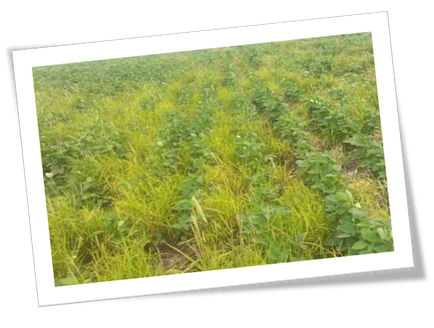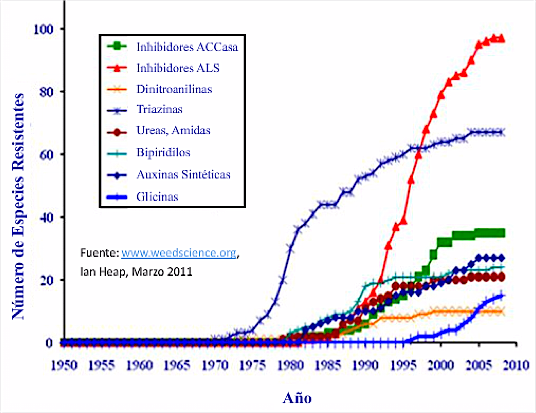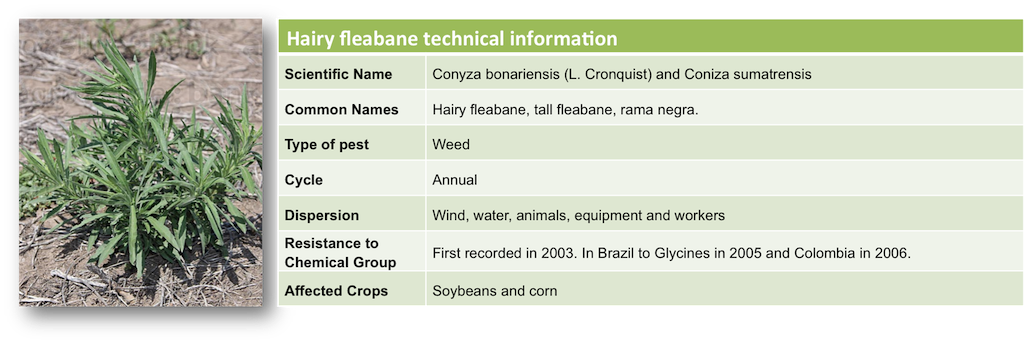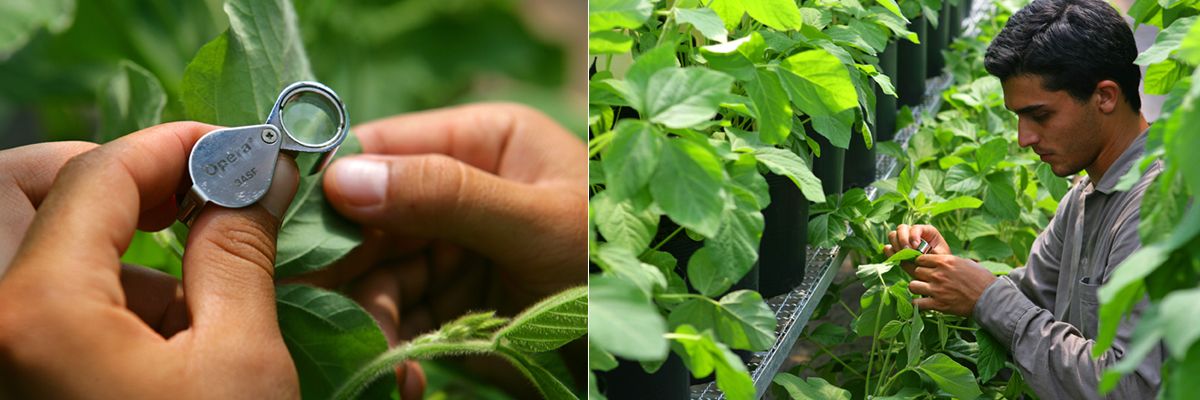Poor agricultural practices result in the emergence of herbicide resistant weeds

-
Poor agricultural practices result in the emergence of herbicide resistant weeds. Without crop and herbicide rotation, weeds adapt to these circumstances and resistance appears.
-
"Johnsongrass" (Sorghum halepense L. Pers) is considered one of the worst weeds in 53 countries because of its invasive nature; in 1930 it was declared a national pest of agriculture in Argentina.
-
According to the Brazilian Agricultural Research Corporation (Embrapa), a plant of "hairy fleabane" (Conyza bonariensis) per square meter may result in losses of 20 kg in soybeans.
-
In Argentina, it is estimated that by 2015, 6 to 7 million hectares may have the presence of Johnsongrass and 12 to 15 million, hairy fleabane.
Guest experts
Luis Eduardo Lanfranconi
Agronomist, M.Sc., Researcher INTA – AER Río Primero, Argentina.
Dionisio Luiz Pisa Gazziero
Agronomist, Doctor and Researcher, Embrapa Soybeans, Brazil.
What are weeds?
They are plant species that are highly adapted to the environment; they grow naturally in human-controlled areas, and have a high dispersion and germination power. These plants grow aggressively and prevent the normal development of the cultivated species, causing important yield loses as they compete with light and nutrients.
What is the difference between resistant and tolerant weeds?
According to the Herbicide Resistance Action Committee (HRAC), the definition of resistance is "the natural and heritable ability of some biotypes of weeds in a given population to survive a herbicide treatment, which otherwise should effectively control the population in normal use conditions". The advance of resistance results from the selection pressure exerted in the population of plants, due to the repeated use of the same herbicide or herbicides of the same mechanism of action, i.e., by poor agronomic practices.
Whereas, tolerance is the natural heritable ability of a species to survive and reproduce following the application of an active ingredient. That is, are those plants that are not controlled by a particular herbicide and were never controlled by that active ingredient.
What is the setting of resistant weeds?
The lack of monitoring and the misuse of herbicides, reveal the fact that some species of weeds have become a growing problem. The indiscriminate use of herbicides of a particular mode of action puts pressure on the weed population; effectively control susceptible weeds and exert selection pressure on the group of plants, which causes the emergence of resistant weeds. The result is a lower efficacy of crop protection technologies, therefore, strategies or practices that delay the selection of resistant weeds should be implemented to preserve these technologies as a key resource in managing weeds.
The number of herbicide resistant weeds continues to increase worldwide, as well as the number of acres scattered with these species. Resistance changes the way a herbicide is used by growers, however so far, there have not been reports of the total loss of use of a specific group of herbicides.
129 weed species are resistant to the acetolactate synthase inhibitors ALS (i.e. Chlorimuron), 69 species are resistant to photosystem II inhibitors (i.e. Atrazine), 42 to ACCase enzyme inhibitors (i.e. Sethoxydim) and 30 to synthetic auxins (i.e. 2,4-D).

Chart with the current situation with resistant weeds. Source: weedscience.org
What is the impact of resistant weeds in Argentina and Brazil?
Argentina
The first case of resistance was found in Argentina in 1996 in biotypes* of pigweed (Amaranthus quitensis) resistant to herbicides inhibiting the enzyme acetolactate synthase (ALS), i.e. imazethapyr, chlorimuron ethyl and flumetsulam. In 2005 and 2006 glyphosate resistance was observed in biotypes of Johnsongrass, and studies conducted during 2007 in the southwest of the Buenos Aires province documented the existence of populations of ryegrass (Lolium spp.) resistant to this active ingredient.
The area with resistant weeds continues increasing each year. In 2008 resistance was confirmed in Cynodon hirsutus (tame turf or gramilla mansa) in the center of Córdoba, Raphanus sativus (Radish) in Southeast Buenos Aires Province and more recently Eleusine indica (goose grass) in the center of Córdoba.
It should be noted that in Argentina, the affected area by resistant weeds so far does not reach an important scale, its progress is of concern and the production costs increase in the affected lots it is significant; the projection of this problem is critical because growers and technicians do little to address it.
Awareness campaigns on the impact of combines on seed dissemination have not been conducted yet, and although growers recognize this situation they do not react proactively and take appropriate prevention measures. Clearly, the affected lot loses sustainability by the increase in production costs, however, with good control yields should not decrease. The weeds that have most impact in the production system are Sorghum halepensis and Amaranthus palmeri, the first at national level and the second mainly in the south-west of Córdoba.
Before the 80s, hairy fleabane was only problematic in pastures, as in areas with intensive and extensive conventional cultivation, tillage did not allow the weed to develop.
Currently with the widespread use of no-tillage, the advance of hairy fleabane is widespread and it affects the whole national agricultural area, with the highest incidence in the core Pampas region. In 2012 delayed applications due to heavy rains worsened the problem, plus soybeans were planted in fields where hairy fleabane stood alive, preventing its effective control.
Projections for 2015 are alarming, it is estimated that by that year there would be between 6 and 7 million hectares with the presence of Johnsongrass (Sorghum halepense L. Pers) and 12 million hectares with hairy fleabane (Conyza bonariensis).
According to INTA (National Agricultural Technology Institute), the toughest weeds for resistance are Johnsongrass, Lolium multiflorum and L. perenne, E. colona (jungle rice), hairy fleabane, shrubby false-buttonweed (Borreria verticillata), globe amaranth (Gomphrena pulchella and G. perennis), Chloris spp. and Trichloris spp. It is said that the outbreaks do not come from other places, but originate in the place itself. This was indicated in studies conducted by researchers at UBA (University of Buenos Aires) and INTA.
Brazil
According to Dionisio Luiz Pisa, Embrapa Soybean Agronomist, currently 90% of the area seeded with soybeans is resistant to glyphosate (Glycine Chemical Group). It is estimated that the greatest problems with resistant weeds are in the south of Brazil but it is difficult to state exactly those percentages, plus there is no data for the central region of Brazil, but it is known that the problem is starting in that region.
In the South region it can be assumed that the problem is serious in about 6 million hectares, since hairy fleabane has spread in the productive areas.
The official identified and recorded glyphosate-resistant biotypes in Brazil are: Conyza bonariensis (hairy fleabane), Conyza canadensis (horseweed), Conyza sumatrensis (tall fleabane), Lolium multiflorum (annual ryegrass), and Digitaria insularis (sour grass).
Description of the main resistant weeds
- Hairy fleabane, highly resistant weed.

- Johnsongrass

Researchers from the Agronomy School at UBA (FAUBA) and CONICET (National Scientific and Technical Research Council) argue that ecological conditions related to soil type and high temperature favor the development of resistance of Johnsongrass in northern Argentina, because it is a tropical weed.
- Sour grass

- Annual ryegrass

Implications of weed resistance
- Requires changes in weed and crop management practices.
- Increased production costs in weed control by increase the demand for herbicides and control practices
- Reduces the viability of herbicides.
- Loss of production potential (low yields) and lower profitability.
What recommendations can be taken into account in the prevention and control of resistant weeds?
- Crop rotation allows the use of an increased number of herbicides with different modes of action. Applying at different times, for example pre-emergent and post-emergent, and improving planting density.
- Apply the recommended rate as indicated in the herbicide label.
- Keep weeds controlled throughout the growing season, avoiding fructification and that they successfully spread.
- Remove resistant plants that may have been uncontrolled in the field, it is necessary to prevent them from completing their cycle.
- Consider preventive control, clean equipment such as combines before leaving the lots, then burn or destroy the remnants of the cleaning to avoid its spreading.
- Use clean certified seed.
- Use alternatives to one way of applying the product for more effective control.
- Practice post emergent mechanical control in the crop.
* Group of plants within a given species with biological characteristics that are not common to other individuals in the population.
Consulted sources:
- Alerta por el fuerte avance de las malezas. Periódico “La Nación”, Argentina. 22 de diciembre del 2012.
- Carlos Ramos Venâncio. 2012. Resistencia de plantas daninhas a herbicidas no Brasil e no mundo. Ministério da Agricultura, Pecuária e Abastecimento.
- Leguizamón, Eduardo. 2011. Manejo de malezas problema. Rama negra: Conyza bonariensis (L. Cronquist). Bases para su manejo y control en sistemas de producción. Red de conocimiento en malezas resistentes REM. Argentina.
- En: https://www.rem.org.ar/images/pdf/LibroREM-RamaNegra.pdf .


















